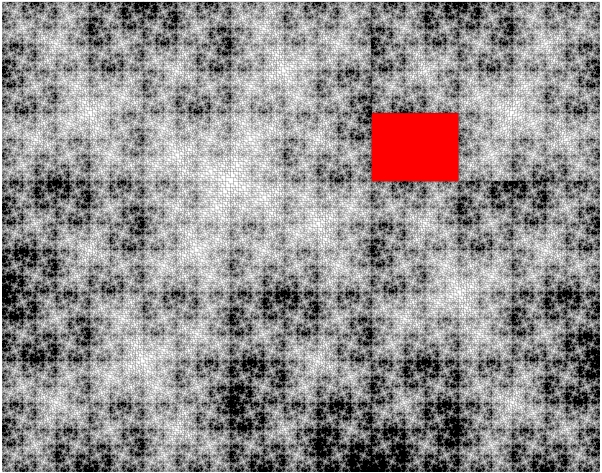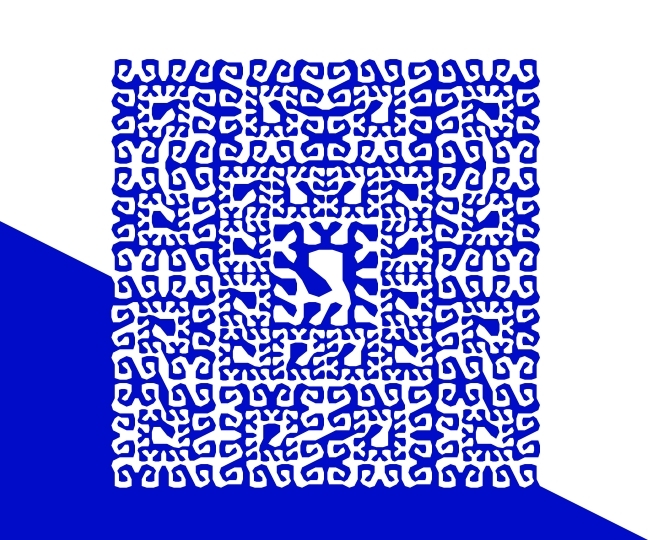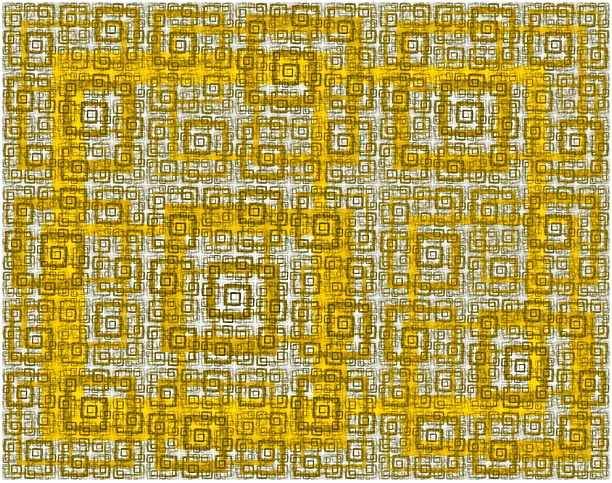Douglas McKenna
“Golden Gnomon”
Limited edition Giclee print in each of small, medium and large formats, 19"
x 16" (small), 2007, based on a pen plotter drawing circa 1985

In Greek geometry, the word "gnomon" meant: That which is left over after removing
a self-similar part. Robert Ammann discovered a variety of golden-ratio-based,
aperiodic tilings. One tile, when removed from its bounding rectangle, leaves
a gnomon having the same shape as the bounding rectangle, creating "self-gnomicity".
Playing with this idea after meeting Ammann, I first drew this piece in 1985,
as a plotter drawing. Both the geometry and a mysterious "tie-die" texture/structure
emerges when our visual system integrates myriad tiny details. To the discerning,
the Fibonacci numbers evince themselves also.
Douglas McKenna, Freelance Artist, Software Developer, President, Mathemaesthetics,
Inc.
"Since childhood, I have been enamored of the textures and structures evinced
by recursive subdivisions, hierarchical tilings, self-referential designs, and
space-filling curves, all formed by algorithmically traversing trees of linear
or other transformations. Even before I helped illustrate the geometric fractal
portions of Mandelbrot's "The Fractal Geometry of Nature", I was drawing them
by hand, or using primitive 1970s-era computer graphics. In mathematical art,
the balance between platonic and aesthetic beauty is difficult to achieve. Symmetry
represents a loss (or compression) of information, and is rarely the basis of
good art. Yet in math, symmetry is considered essentially beautiful. To me,
a tension between symmetry and asymmetry seems integral to notions of visual
beauty. My pieces, some of which rely on my own space-filling curve results,
are intended not only to illustrate a mathematical principle, but also to please
the eye with structural or textural intrigue. "
http://www.mathemaesthetics.com/MathArtPrints.html
Other works by the artist
“Thirteenski”
Limited edition Giclee print in each of small, medium and large formats, 22" x 18" (small), 2007.
The original Peano and Hilbert Curves represent two out of three techniques for "threading a square". The generalized third technique I recently conceived connects square corners with side centers. "Thirteenski" is an asymmetric, recursive traversal of 13 symmetrically arranged sub-squares that eventually converges as a space-filling curve at different geometric scales according to a Sierpinski Carpet-like pattern. The resulting pattern wonderfully illustrates a struggle between symmetry and asymmetry, arising from the underlying combinatoric constraints governing the solution space.
“Phiberspace”
Limited edition Giclee print in each of small, medium and large formats, 19" x 16" (small), 2007
This piece consists of nothing more than a large number of rectangular outlines, chosen in such a way that they overlap with themselves so that our visual system integrates them all into myriad, hierarchically distributed spirals. Smaller rectangles are drawn with thinner lines and darker colors. The underlying tree of transformations represents a recursive subdivision based on the square root of the golden ratio, and the colors were chosen to evoke goldenness. The title is a triple-entendre, connoting the Golden Ratio, the cloth-like fuzziness, and pervasive, self-similar inter-connectedness.